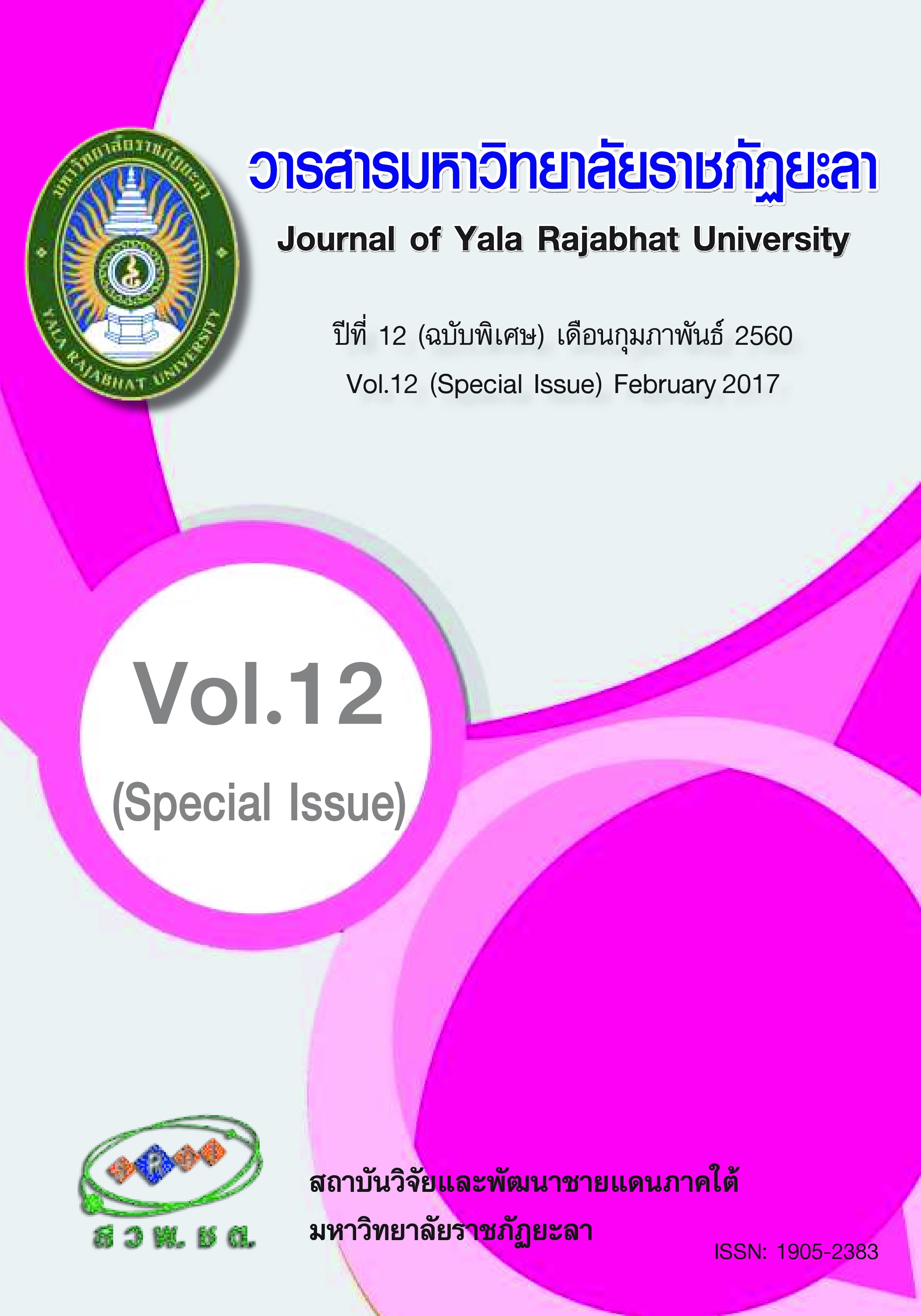ประสิทธิผลของการสอนคำปรากฏร่วมประเภทคำศัพท์ต่อความรู้ด้านคำปรากฏร่วมของนักเรียน
Main Article Content
บทคัดย่อ
งานวิจัยนี้มีจุดประสงค์เพื่อทดสอบประสิทธิผลของการสอนคำปรากฏร่วมประเภทคำศัพท์ ในการเสริมสร้างความรู้เรื่องคำปรากฏร่วม ของนักเรียนที่เรียนภาษาอังกฤษเป็นภาษาต่างประเทศ (EFL) โดยกลุ่มตัวอย่างในงานวิจัยกึ่งทดลองนี้ เป็นนักเรียนที่เรียนภาษาอังกฤษเป็นภาษาต่างประเทศ (EFL) ชั้นมัธยมศึกษาปีที่ 6 หลักสูตรวิทยาศาสตร์-คณิตศาสตร์ จำนวน 30 คน ซึ่งกำลังศึกษาในโรงเรียนมัธยมศึกษาของรัฐบาล ข้อมูลวิจัยได้เก็บรวบรวมโดยใช้ข้อสอบเพื่อทดสอบความรู้คำปรากฏร่วม ซึ่งใช้เป็นข้อสอบก่อนและหลังการสอนคำปรากฏร่วม ผู้วิจัยได้ออกแบบแบบฝึกเรื่องคำปรากฏร่วมประเภทคำศัพท์ จำนวน 15 แบบฝึก เพื่อสอนคำปรากฏร่วมแก่กลุ่มตัวอย่าง ในรายวิชาภาษาอังกฤษหลัก จำนวน 30 ช่วโมง การวิจัยนี้ใช้การวิเคราะห์ค่าสถิติพื้นฐาน (Descriptive statistic) และการทดสอบความสัมพันธ์ระหว่างค่าเฉลี่ยที่กลุ่มตัวอย่างมีความสัมพันธ์กัน (Dependent sample t-test) ในการวิเคราะห์ข้อมูลเชิงปริมาณเพื่อเปรียบเทียบคะแนนสอบก่อนและหลังการสอนคำปรากฏร่วมของกลุ่มตัวอย่าง ผลการวิจัยพบว่า คะแนนสอบหลังการสอนคำปรากฏร่วมของกลุ่มตัวอย่างเพิ่มขึ้นอย่างมีนัยสำคัญ กลุ่มตัวอย่างทำคะแนนดีที่สุดในข้อสอบคำปรากฏร่วมประเภทย่อย คำกริยา+คำนาม (verb+noun) แต่คะแนนต่ำที่สุดในข้อสอบคำปรากฏร่วมประเภทย่อย คำกริยา+คำวิเศษณ์ (verb+adverb) จะเห็นได้ว่า หลังจากการสอนคำปรากฏร่วมประเภทคำศัพท์ กลุ่มตัวอย่างได้รับความรู้เรื่องคำปรากฏร่วมจากการสอนและการใช้แบบฝึกคำปรากฏร่วม อย่างไรก็ตามยังมีคำปรากฏร่วมประเภทย่อยบางประเภท ที่เป็นปัญหาแก่กลุ่มตัวอย่างในการรับรู้แม้จะได้เรียนมาแล้วก็ตาม
Article Details
บทความ ข้อมูล เนื้อหา รูปภาพ ฯลฯ ที่ได้รับการเผยแพร่ในวารสารมหาวิทยาลัยราชภัฏยะลานี้ ถือเป็นลิขสิทธิ์ของวารสารมหาวิทยาลัยราชภัฏยะลา หากบุคคลหรือหน่วยงานใดต้องการนำทั้งหมดหรือส่วนหนึ่งส่วนใดไปเผยแพร่ต่อหรือกระทำการใดๆ จะต้องได้รับอนุญาตเป็นลายลักษณ์อักษรจากวารสารมหาวิทยาลัยราชภัฏยะลาก่อนเท่านั้น
เอกสารอ้างอิง
2.Boonyasaquan, S. (2006). The Lexical Approach: An Emphasis on Collocations [Electronic Version]. Journal of Humanities, 28, 98-108.
3.Hill, J. (2000). Revising Priorities: From Grammatical Failure to Collocational Success. In M. Lewis, Teaching Collocation: Further Developments in the Lexical Approach. London: Language Teaching Publications.
4.Kala, P. (2012). Collocation Instruction to Enhance English Vocabulary Knowledge and Writing Ability among Mathayom Suksa 5 Students [Online]. Retrieved May 19th, 2015, from: http://tdc.thailis.or.th.
5.Lewis, M. (1993). The Lexical Approach: The state of ELT and a way forward. London: Language Teaching Publications.
6.Lewis, M. (1997). Implementing the Lexical Approach: Putting Theory. London: Commmercial Colour Press Plc.
7.Lewis, M. (2000). Teaching Collocation: Further Developments in the Lexical Approach. London: Language Teaching Publications.
8.McCarthy, M. & O’Dell, F. (2005). English Collocations in Use. Cambridge: Cambridge University Press.
9.McIntosh, C. (2009). Oxford Collocations Dictionary for Students of English. Oxford: Oxford University Press.
10.Mongkolchai, A. (2008). A Study of University Students’ Ability in Using English Collocations. Master’s Project, M.A. (English). Graduate School, Srinakharinwirot University.
11.Nation, I. S. (2001). Learning Vocabulay in Another Language. Cambridge: Cambridge University Press.
12.Ozgul, B. & Abdulkadir, C. (2012). Teaching Vocabulary through Collocations in EFL Classes: The Case of Turkey. International Journal of Research Studeies in Language Learning, 1, 21-32.
13.Phoocharoensil, S. (2013). Cross-linguistic Influence: Its Impact on L2 English Collocation Production. English Language Teaching, 6(1), 1-10
14.Phoocharoensil, S. (2014). Exploring Learners’ Developing L2 Collocational Competence. Theory and Practice in Language Studies, 4(12), 2533-2540.
15.Shooshtari, Z. G. & Karami, N. (2013). Lexical Collocation Instruction and Its Impact on Non-academic EFL Learner’s Speaking Ability. Journal of Language Teaching and Research, 4(4), 767 - 776.
16.Usen, A. (2015). Effectiveness of Teaching Collocations to Primary School Students (Grade 6). 7th International Conference on Humanities and Social Sciences “ASEAN 2015: Challenges and Opportunities”. Songkhla: Faculty of Liberal Arts, Prince of Songkhla University.
17.Wei, Y. (1999). Teaching collocations for productive vocabulary development. Paper presented at the Annual Meeting of the Teachers of English to Speakers of Other Language. New York.
18.Yumanee, C. & Phoocharoensil, S. (2013). Analysis of Collocational Errors of Thai EFL Students. LEARN Journal: Language Education and Acquisition Research Network, 6(1), 90-100.


